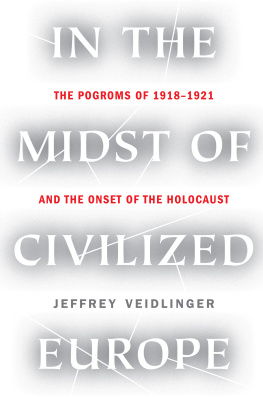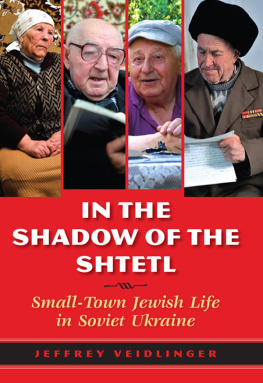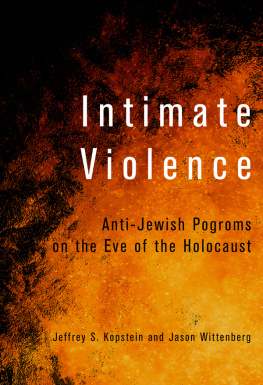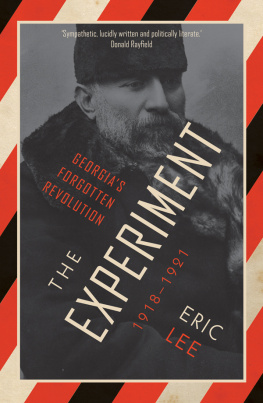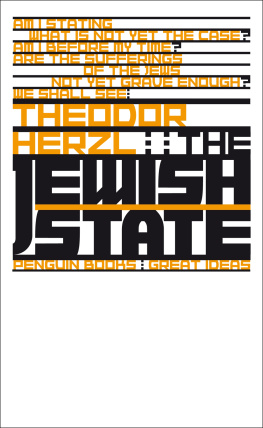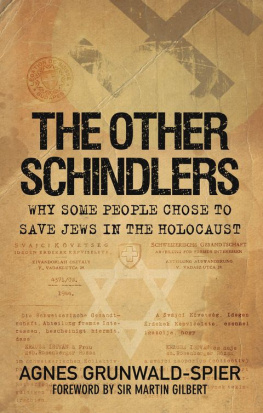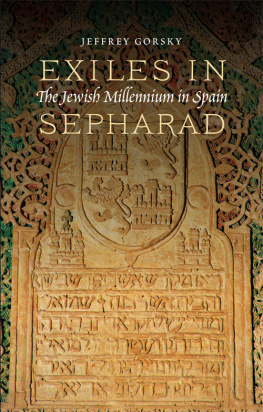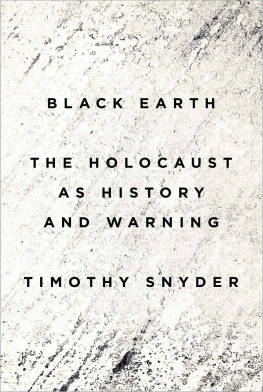In the very midst of civilized Europe, at the dawn of the new era for which the world awaits its charter of liberty and justice, the existence of a whole population is threatened. Such crimes dishonour not only the people that commit them, but outrage human reason and conscience.
A NATOLE F RANCE , 1919
Contents
In the years after the Holocaust, survivors around the globe began compiling memorial books, one for each city and town. These literary monuments to destroyed communities preserved local stories and documented the names of victims to keep memory alive. As a historian of eastern European Jewry, I have long appreciated the way these memorial books provide insight into the everyday rhythms of ordinary life. In them, contributors share anecdotes about the local schools, the fire brigade orchestra, the soccer club, the Zionist youth group. They paint portraits of local celebrities whose fame extended only as far as the wheat fields around the town: a favorite teacher, a respected rabbi, the town councilor, the water porter everybody knew. They document events small and large: the time a Jewish soldier returned home from the Russo-Japanese War, the time a traveling theater troupe from Odesa came to town, the time a fire burned down Yankl Friedmans inn, the day the Nazis arrived.
But such memorial books are not only histories of the prewar period; they are also prehistories of the war itself. Take, for instance, the memorial book from the town of Proskuriv, located in todays Ukraine. The books title, Khurbn Proskurov, captures the calamity the city endured. The Yiddish word khurbn (destruction), a term derived from the Hebrew urban, denotes the destruction of the two biblical temples in the sixth century BCE and the first century CEthe ur-catastrophes of the Jewish peopleand has since been used to describe an array of other disasters, from earthquakes to the sinking of the Titanic. After the Second World War, it became widely understood to refer to the fate of European Jewry under the Nazis.
As is typical of memorial books, Khurbn Proskurov begins with a dedication: To the memory of the holy souls who perished during the terrible slaughter that befell the Jews of Proskuriv. The frontispiece depicts a common image in Holocaust art, a single memorial candle and a rosebush with thorny stems evoking barbed wire. A landscape of rolling fields beneath a city on a hill suggests the bucolic countryside around Proskuriv, with fields of flax and wheat and orchards of cherries and plums. As in many such memorial books, the text is in Yiddish and Hebrew and includes a foreword by a well-known townsmanin this case, the folklorist Avrom Rechtman. There are the usual tales of local personalities and municipal institutions. The book concludes with the names of the martyred, a list that extends to thirty pages.
What differentiates Khurbn Proskurov, though, is that it was written in 1924nine years before Hitlers rise to power and fifteen years before the start of the Second World War. Meanwhile, thirteen hundred miles to the east, on the afternoon of February 15, 1919, Ukrainian soldiers murdered over a thousand Jewish civilians in what was at the time possibly the single deadliest episode of violence to befall the Jewish people in their long history of oppression.

Frontispiece to Khurbn Proskurov
The massacre in Proskuriv was not an isolated event. Between November 1918 and March 1921, during the civil war that followed the Great War, over one thousand anti-Jewish riots and military actionsboth of which were commonly referred to as pogromswere documented in about five hundred different locales throughout what is now Ukraine, and which was at the time contested territory between Russian, Polish, Ukrainian, and multinational soviet successor states of the Russian and Austro-Hungarian empires.
This was not the first wave of pogroms in the area, but its scope eclipsed previous bouts of violence in terms of the range of participants, the number of victims, and the depths of barbarity. Ukrainian peasants, Polish townsfolk, and Russian soldiers robbed their Jewish neighbors with impunity, stealing property they believed rightfully belonged to them. Armed militants, with the acquiescence and support of large segments of the population, tore out Jewish mens beards, ripped apart Torah scrolls, raped Jewish girls and women, and, in many cases, tortured Jewish townsfolk before gathering them in market squares, marching them to the outskirts of town, and shooting them. On at least one occasion, insurgent fighters barricaded Jews in a synagogue and burned down the building. The largest of the anti-Jewish massacres left over a thousand people dead, but the vast majority were much smaller affairs: more than half the incidents resulted only in property damage, injury, and at most a few fatalities. The numbers are contested, but a conservative estimate is that forty thousand Jews were killed during the riots and another seventy thousand subsequently perished from their wounds, or from disease, starvation, and exposure as a direct result of the attacks. Some observers counted closer to three hundred thousand victims. Although that higher figure is likely exaggerated, most historians today would agree that the total number of pogrom-related deaths within the Jewish community between 1918 and 1921 was well over one hundred thousand. The lives of many more were shattered. Approximately six hundred thousand Jewish refugees were forced to flee across international borders, and millions more were displaced internally. About two-thirds of all Jewish houses and over half of all Jewish businesses in the region were looted or destroyed. The pogroms traumatized the affected communities for at least a generation and set off alarms around the world.
I HAD ALWAYS thought that the Holocaust was simply inconceivable before it happenedthat it was beyond the ability of humans to imagine, to predict, or to prepare for. My father, whose story of survival informed my early knowledge of the Holocaust, emphasized how normal everything seemed before. He lived an upper-middle-class life in Budapest, enjoying fencing lessons and family vacations at Lake Balaton, until the Nazi invasion of Hungary in March 1944. Likewise, the most famous victims of the Holocaust had their first encounters with genocidal antisemitism only several years into the war. Anne Frank went into hiding in July 1942, and the Gestapo discovered her secret annex in August 1944. Elie Wiesel reports that he first heard rumors of massacres as early as 1941, but it was not until May 1944 that he was deported to Auschwitz from the Sighetu Marmatiei ghetto, which had been set up a few weeks earlier. Many popular portrayals of the Holocaust similarly emphasize the suddenness and unexpectedness of what took place. When I bring my students to the Holocaust Memorial Center in Farmington Hills, Michigan, for instance, they enter the exhibition in a large open space filled with Jewish ritual objects and photos of everyday Jewish life in Europe, testifying to a vibrant, rooted existence. Then, turning a corner, they encounter a massive portrait of Adolf Hitler looming over a long hallway that descends into the next exhibit room. The impression is that Hitler appeared out of the blue, with no hint of the coming apocalypse.
But the evidence is clear that the murder of six million Jews in Europe was not only conceivable but feared as a distinct possibility for at least twenty years before it became a reality. On September 8, 1919, for instance, the

